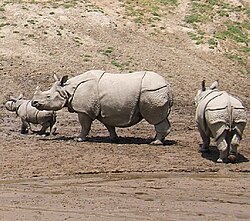This article needs additional citations for verification .(April 2016) |
| Rhinoceros Temporal range: Late Miocene-Recent | |
|---|---|
 | |
| Indian rhinoceros (R. unicornis) | |
| Scientific classification | |
| Kingdom: | Animalia |
| Phylum: | Chordata |
| Class: | Mammalia |
| Order: | Perissodactyla |
| Family: | Rhinocerotidae |
| Tribe: | Rhinocerotini |
| Genus: | Rhinoceros Linnaeus, 1758 |
| Type species | |
| Rhinoceros unicornis Linnaeus, 1758 | |
| Species | |
Rhinoceros is a genus comprising one-horned rhinoceroses. This scientific name was proposed by Swedish taxonomist Carl Linnaeus in 1758. [1] The genus contains two species, the Indian rhinoceros (Rhinoceros unicornis) and the Javan rhinoceros (Rhinoceros sondaicus). Although both members are threatened, the Javan rhinoceros is one of the most endangered large mammals in the world with only 60 individuals surviving in Java (Indonesia). The word 'rhinoceros' means "nose-horn" in Ancient Greek.[ clarification needed ]








